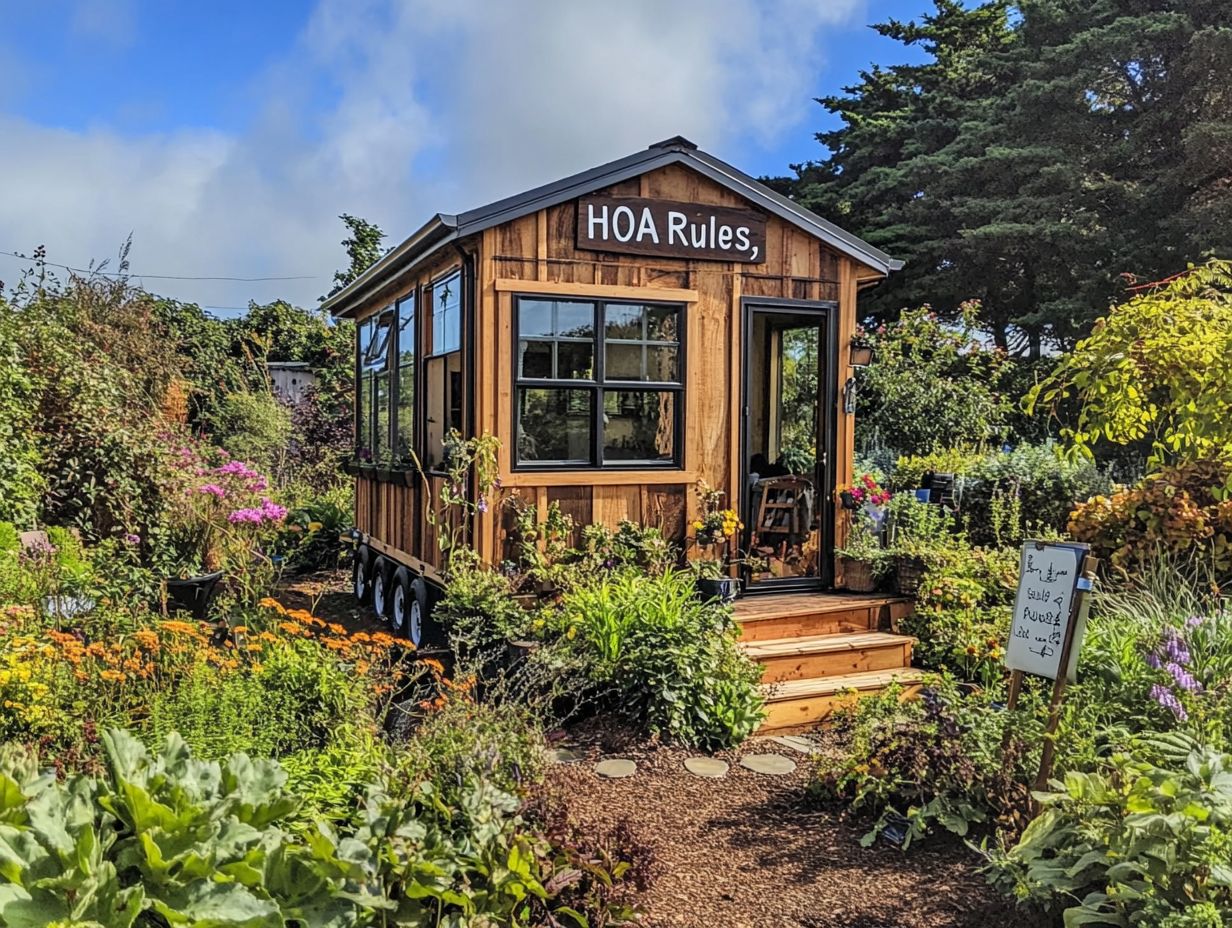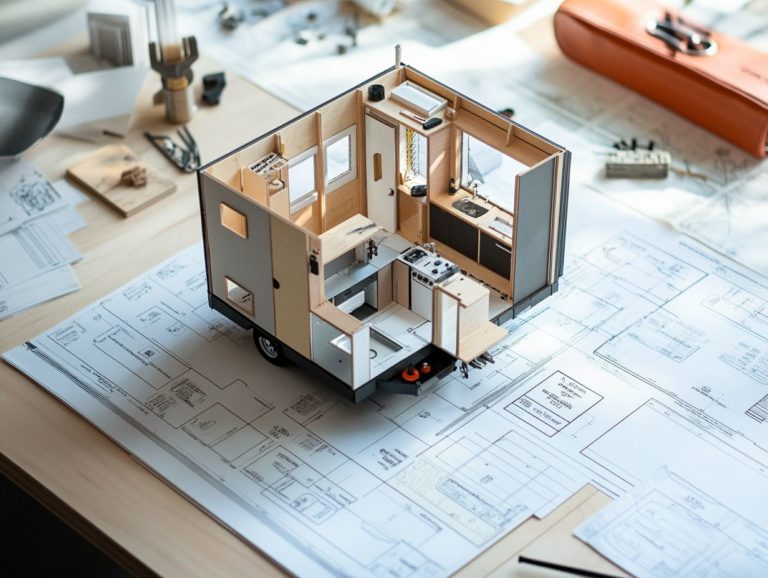Tiny House HOA Rules: What to Consider
Are you contemplating the allure of tiny house living? Before you jump into it, take a moment to think about a few important factors, especially the distinctive realm of Homeowner Associations (HOAs) that often oversee these communities.
From rules regarding size and design to the intricacies of fees and shared amenities, understanding HOA regulations can profoundly influence your tiny house experience.
Let s dive into essential aspects of HOA rules, key factors to weigh before making the move, and strategies for cultivating a harmonious relationship with your HOA.
Set the stage for your tiny living journey, ensuring it begins on the right note!
Contents [hide]
- Key Takeaways:
- Understanding Tiny House HOA Rules
- Factors to Consider Before Moving into a Tiny House Community
- Common HOA Rules for Tiny House Communities
- Navigating HOA Rules as a Tiny House Owner
- Frequently Asked Questions
- What are Tiny House HOA Rules?
- What should I consider before choosing to live in a tiny house within an HOA community?
- What are some common rules in Tiny House HOAs?
- Can I make changes to my tiny house within an HOA community?
- What happens if I violate the Tiny House HOA Rules?
- Can I opt out of following the Tiny House HOA Rules?
Key Takeaways:

- Before moving into a tiny house community, consider the location, local laws, and HOA fees and restrictions.
- Tiny house communities often have size and design rules as well as guidelines for community amenities and shared spaces.
- As a tiny house owner, effective communication with the HOA board and conflict resolution skills are crucial for navigating HOA rules.
Understanding Tiny House HOA Rules
Understanding the rules established by Homeowner Associations (HOA) is essential for anyone engaged in the tiny house movement. These regulations can significantly affect your experience and lifestyle as a tiny homeowner.
Local municipalities also impose building codes and laws that dictate how tiny houses are constructed, where they can be situated, and the amenities that must be included. For those navigating these regulations, seeking tiny house legal advice can be extremely helpful. This influences not only property tax considerations but also the overall aesthetic of tiny house communities.
What are HOA Rules and How do They Apply to Tiny Houses?
HOA rules are the regulations set by homeowner associations that dictate how properties within a community should behave and appear, impacting you as a tiny house owner.
These guidelines aim to maintain property values, promote aesthetic harmony, and uphold communal standards, influencing various aspects of tiny house living. While your small dwelling may offer a sustainable and innovative lifestyle, navigating HOA rules can present notable challenges. For instance, understanding the importance of zoning is crucial, as restrictions on size, design elements, and exterior colors might stifle the creativity and uniqueness you wish to showcase in your tiny home.
Such regulations can also affect the overall look of the community, as tiny houses may not fit the traditional models often preferred by HOAs. Therefore, it’s essential for you to carefully weigh whether your dreams of minimalist living align with the established norms of the community you wish to join, including understanding tiny house laws.
Factors to Consider Before Moving into a Tiny House Community
Before you embark on your journey to a tiny house community, it’s crucial to assess several key factors. Consider the location, local laws, and any relevant zoning codes carefully.
These elements are vital for ensuring a harmonious and fulfilling living experience in your new environment.
Location and Local Regulations

The location of a tiny house community is vital, as it directly impacts local regulations, including tiny house laws and building codes, which can vary widely between municipalities.
Understanding these differences is crucial your tiny house dream depends on it! For instance, some areas may embrace sustainability by promoting tiny living, offering you flexibility in zoning codes, while others may enforce strict regulations that require compliance with traditional housing standards.
Navigating these local nuances can either challenge or enable you in your quest to downsize your lifestyle.
Thus, conducting a thorough review of local guidelines is highly advisable before you settle on a location, ensuring that your dream of tiny living harmonizes with community norms and legal frameworks.
HOA Fees and Restrictions
HOA fees represent a financial commitment that you may often need to embrace when residing in a tiny house community. These fees help support community management, maintenance, and shared amenities that enhance your living experience.
This financial obligation can significantly impact your overall budget, influencing everything from your monthly mortgage payments to property taxes. More often than not, as a tiny homeowner, you find yourself juggling the enticing simplicity of minimalist living with the reality of these recurring costs, including tiny house parking legal guidelines.
The restrictions imposed by Homeowners Associations can further complicate your lifestyle choices, controlling everything from how you can modify your home’s exterior to the types of landscaping permitted. For those considering tiny homes, understanding the legal considerations of tiny house land ownership is crucial.
These limitations affect your personal expression and functionality and can also have a ripple effect on property values in the area. This highlights the intricate relationship between HOA governance and the true essence of tiny living, making it essential to navigate these waters thoughtfully, especially considering tiny house legal challenges.
Common HOA Rules for Tiny House Communities
In tiny house communities, you’ll often encounter common HOA rules that impose design restrictions and guidelines. These are thoughtfully crafted to uphold the community’s aesthetic and coherence.
Such regulations also play a significant role in shaping the availability of community amenities and shared spaces, ensuring that everything aligns harmoniously with the overall vision of the neighborhood. For tiny house owners, understanding legal obligations is essential in this context.
Size and Design Restrictions
Size and design restrictions are important rules within HOA regulations that govern tiny houses, often controlling the minimum square footage, which is the smallest area your tiny house can occupy, and the architectural styles permissible in your community.
These regulations significantly shape your living experience, influencing everything from how you configure your limited space to the aesthetic harmony of the neighborhood. As a tiny house enthusiast, you may find yourself navigating your dreams amidst these rules, occasionally at odds with local building codes that lay out requirements for safety, structural integrity, and utilities. To better understand these complexities, refer to tiny house licensing: what you need to know.
The design nuances you choose must strike a balance between modern and traditional styles. Your personal expression shouldn t disrupt the community’s visual cohesion. This delicate dance between individuality and conformity is a recurring theme for anyone embracing this minimalist lifestyle, frequently leading to innovative solutions that harmonize unique visions with community expectations.
Community Amenities and Shared Spaces

Community amenities and shared spaces in tiny house communities are essential elements that encourage socializing and cultivate a genuine sense of belonging among tiny homeowners. These exciting spaces ranging from communal gardens and fire pits to exercise zones and inviting gathering spots are not just added bonuses; they elevate your living experience into a shared adventure.
Want to host potlucks or movie nights under the stars? By providing venues where you and your neighbors can connect and engage, these spaces foster a spirit of collaboration and shared purpose. However, it’s important to be aware of potential challenges, such as tiny house zoning issues. In this context, community amenities become more than just functional spaces; they intricately weave the fabric of belonging and support that makes tiny house living not only feasible but also profoundly enriching.
Navigating HOA Rules as a Tiny House Owner
Navigating HOA rules as a tiny house owner can be quite the intricate undertaking. You ll need good communication skills and an understanding of community dynamics for a smooth living experience.
Communicating with the HOA Board
Effective communication with the HOA board is essential for tiny homeowners. It nurtures positive relationships and ensures that concerns are addressed swiftly within the tiny home community.
By actively engaging with board members, you can foster a collaborative environment that encourages open dialogue. Techniques such as attending meetings consistently, participating in community events, and establishing a feedback loop a way to share and receive opinions and suggestions can significantly enhance your engagement.
Using constructive language and expressing appreciation for the board s efforts helps build goodwill. It also increases the chances of your viewpoints being acknowledged.
Building strong relationships with HOA representatives creates a more supportive atmosphere, ultimately benefiting the entire community.
Resolving Conflicts and Disputes
Resolving conflicts and disputes within a tiny house community requires a solid grasp of HOA rules and proactive steps to create harmony among residents.
Effective community management fosters open communication and mutual respect among neighbors. By understanding HOA regulations and tiny house residency laws you should know, you set clear expectations and establish a framework for addressing grievances. Regular community meetings are a great way to facilitate discussions, allowing everyone to voice concerns and share ideas.
Implementing mediation strategies, such as appointing a neutral third party, can provide valuable assistance in resolving contentious issues. By prioritizing collaboration and respecting established guidelines, you contribute to a more positive living environment that benefits everyone involved.
Frequently Asked Questions

Curious about Tiny House HOA Rules? Here are some common questions and answers!
What are Tiny House HOA Rules?
Tiny House HOA Rules are regulations set by a Homeowners Association for individuals living in tiny houses within their community. These rules ensure the safety, comfort, and well-being of all residents.
What should I consider before choosing to live in a tiny house within an HOA community?
Before choosing to live in a tiny house within an HOA community, consider the rules and regulations set by the HOA, the size and design restrictions for tiny houses, and the overall vibe and atmosphere of the community.
What are some common rules in Tiny House HOAs?
Common rules in Tiny House HOAs may include restrictions on size and design of tiny houses, limitations on the number of occupants, noise regulations, and landscaping guidelines.
Can I make changes to my tiny house within an HOA community?
You usually need approval from the HOA board for changes to your tiny house. This includes any exterior modifications or additions.
What happens if I violate the Tiny House HOA Rules?
If you violate the Tiny House HOA Rules, you may face consequences such as fines, community service, or even eviction from the community. It is crucial to carefully review and follow all rules to avoid potential penalties.
Can I opt out of following the Tiny House HOA Rules?
No, as a resident of a tiny house within an HOA community, you must follow all rules and regulations set by the HOA. These rules maintain the community’s overall standards and should be respected by all residents.
Have more questions? Reach out to your HOA board today!






